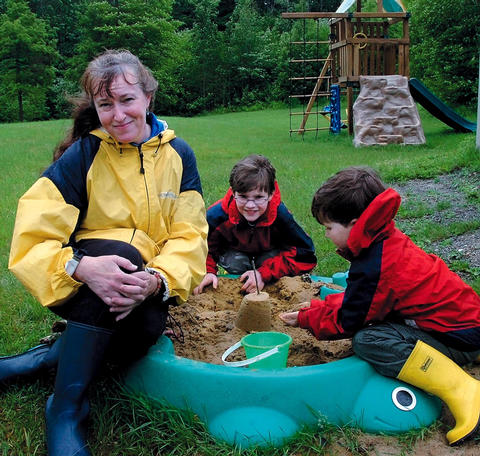There’s no evidence of a sustained, wild population of mountain lions in Maine, according to officials of the state. Despite that, there are have been some new incidents of some interest.
“I’m intrigued,” Jakubas said. “We had this report of the scat (in Augusta). I think the important thing is these are unconfirmed reports and the general history of these things is, when you look into them, they don’t pan out.”
Even so, the Winslow sighting “is a very convincing story,” he said, and a state biologist from the department’s Sidney office is investigating.
The sighting occurred around 4:45 p.m. Lin Stout said she and her sons Cullen, 9, and Liam, 5, were at a swing set in their backyard off South Ridge Drive when they saw the long tail bobbing through ferns and brush. They live on a 5-acre property within a subdivision that is surrounded by woods.
The tan tail, standing about 3 feet high, had a 3-inch, dark brown tip, Stout said. It was about 20 feet away, she said. Cullen ran back to the house; Liam and his mother watched.
“My 5-year-old says, ‘Mommy, a lion’s tail!’ I said, ‘It’s not like a lion you see at the zoo; it’s a mountain lion,'” Stout said.
Stout said they were about 30 feet away from the house and back deck. They froze in place as the tail disappeared back into the brush, silently.
“We did not hear any snaps of twigs, no crunches of leaves; it was like it was a ghost,” Stout said. “My son said it’s a ghost cat.”
Stout said she and her son began slowly walking back toward the house when the animal stepped out from the woods — in full view — less than 20 feet away from them. Stout said she recognized the animal as a mountain lion, describing it as perhaps weighing 130 pounds, with a large cat-like face, yellow eyes, “huge” paws, and that long tail they had seen in the brush.
Racing through Stout’s mind was the thought of what she would do if the animal leaped at them. She decided to drop to the ground and cover her son, if it came to that.
But Stout said the mountain lion seemed uninterested in them and focused on a nearby marsh area. Stout said they began slowly backing up because the mountain lion seemed not to be interested in them.
“It didn’t look menacing to us; it didn’t growl or show its teeth,” Stout said. “It was looking at the marsh. I didn’t feel that afraid; I felt more calm.”
Then, as Stout picked up her son, the 5-year-old screamed.
“I think he realized then this was a very large animal and it was wild,” she said. “That startled the animal, but it did not ever come at us.”
That’s also when Stout finally saw what the animal had been fixated on: a black, domestic cat that had wandered into the marsh area. Liam, she said, screamed, “Run kitty, run!”
Stout said the mountain lion then took one giant leap back into the woods — without making a sound. The entire encounter with the animal in full view lasted perhaps 30 seconds, Stout said.
After the encounter, Stout contacted Charles Theobald, animal control officer for the Winslow Police Department.
The animal fit the description of an eastern mountain lion, Theobald said. He suggested that the Stouts take extra precautions when going out in the area — such as having the kids wear bells.
“It’s wildlife; it’s Maine,” Theobald said. “You’re going to come across wildlife.”
* * *
Apparently the bells would be so the mountain lions will be scared away from the children? And not as some kind of location device to relocate the kids as they were being dragged away by the felines, right? What a weird bit of advice, if you asked me.
 About Loren Coleman
About Loren Coleman
Loren Coleman is one of the world’s leading cryptozoologists, some say “the” leading living cryptozoologist. Certainly, he is acknowledged as the current living American researcher and writer who has most popularized cryptozoology in the late 20th and early 21st centuries.
Starting his fieldwork and investigations in 1960, after traveling and trekking extensively in pursuit of cryptozoological mysteries, Coleman began writing to share his experiences in 1969. An honorary member of Ivan T. Sanderson’s Society for the Investigation of the Unexplained in the 1970s, Coleman has been bestowed with similar honorary memberships of the North Idaho College Cryptozoology Club in 1983, and in subsequent years, that of the British Columbia Scientific Cryptozoology Club, CryptoSafari International, and other international organizations. He was also a Life Member and Benefactor of the International Society of Cryptozoology (now-defunct).
Loren Coleman’s daily blog, as a member of the Cryptomundo Team, served as an ongoing avenue of communication for the ever-growing body of cryptozoo news from 2005 through 2013. He returned as an infrequent contributor beginning Halloween week of 2015.
Coleman is the founder in 2003, and current director of the International Cryptozoology Museum in Portland, Maine.
Email • Facebook • Twitter •

